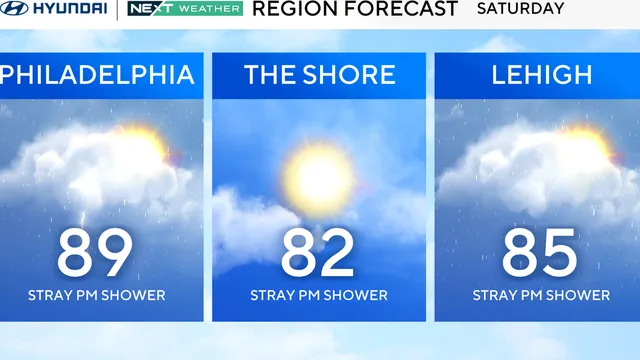
Philadelphia heat wave ends, storms return
2025-06-27 22:33- A record-breaking heat wave has officially ended in Philadelphia, with temperatures cooling down.
- Friday's high is projected to stay in the mid to low 70s, providing relief from the heat.
- The unpredictability of summer weather continues with the possibility of storms returning over the weekend.
Express your sentiment!
Insights
In Philadelphia, significant weather changes have occurred recently, transitioning from a record-breaking heat wave to cooler temperatures as storms approach the area. This heat wave, which was marked by temperatures reaching nearly 100 degrees for the first time in 13 years, has officially ended. Following the extreme heat, residents can expect relief with temperatures dropping into the mid to upper 80s on Thursday, accompanied by increased cloud cover and the potential for scattered storms. The Storm Prediction Center has identified areas of South Jersey and Delaware under a level 1 risk for non-severe thunderstorms, particularly due to gusty winds. On Friday, the cooling trend continues, with daytime highs struggling to reach the 70s, a stark contrast to the previous days of extreme heat. While the weather may appear cloudy and dreary, it provides a welcome break from the oppressive heat, allowing residents to take a reprieve from air conditioning expenses. As the week progresses, temperatures are expected to rise again, symbolizing a return to more typical summer weather patterns for the region. The weekend forecast indicates seasonably warm conditions, although unpredictability remains as scattered showers and thunderstorms are anticipated each day. Humidity levels will rise, bringing back steamy conditions despite the absence of high heat, with dewpoints in the 70s. Overall, the changing weather is pivotal, as it marks a shift not only in daily temperatures but also in weather patterns, highlighting the instability that often characterizes summer months in the area. Looking ahead, there will be periods of both storms and sunshine throughout the upcoming week, including highs approaching 90 degrees on Sunday and into the 90s on Monday. As summer progresses, residents are encouraged to stay informed about local weather updates, given the potential for varying conditions that could impact outdoor activities and overall comfort during the peak of the season.
Contexts
This report examines the historical weather patterns associated with heat waves in Philadelphia, focusing on significant occurrences and their implications on both residents and infrastructure. Philadelphia has a humid subtropical climate characterized by hot, humid summers and cold winters. Heat waves are defined as prolonged periods of excessively hot weather, often accompanied by high humidity, which can exacerbate discomfort and health risks for the city's population. Historical data indicates that Philadelphia has experienced various heat waves, particularly in July and August, due to its geographical location and urban heat island effect, which tends to elevate temperatures in densely built areas. Such climatic conditions have raised concerns regarding public health, energy demand, and urban planning strategies to mitigate adverse effects during extreme heat events. One notable instance occurred in July 1993, when Philadelphia experienced a heat wave that lasted for several days, with temperatures soaring above 100°F. This event led to an increase in heat-related health emergencies, particularly among vulnerable populations such as the elderly and individuals with pre-existing health conditions. The situation prompted local health authorities to implement outreach programs aimed at educating residents about heat safety and the importance of hydration. Similarly, the heat wave in July 2010 underscored the need for strategic responses to rising temperatures, as it caused power outages and increased demand for cooling, thereby placing a strain on the electrical grid. Emergency services reported an uptick in heat-related hospital visits during these peak heat events. Over the years, trends in the frequency and intensity of heat waves in Philadelphia have raised alarms about climate change and its potential impacts. Reports indicate that the city is likely to experience more frequent and severe heat waves in the future, which could lead to increased public health challenges and economic burdens. Long-term studies have suggested that the average number of heat days—days exceeding 90°F—has shown an upward trajectory in Philadelphia, signaling a critical need for adaptive measures. Urban planners and public health officials have begun to focus on resilience strategies, such as increasing green spaces, promoting the use of reflective building materials, and improving access to air-conditioned public facilities to help mitigate the impacts of future heat waves. In conclusion, understanding the historical context of heat waves in Philadelphia is essential for informing policy and decision-making as the city faces a changing climate. The historical pattern showcases not only the immediate health implications associated with extreme heat but also highlights the long-term consequences of urban development and climate variability. Engaging in proactive measures will be crucial for enhancing community resilience and ensuring the safety and well-being of Philadelphia’s residents amidst the increasingly hot summers.